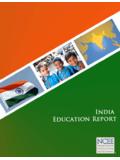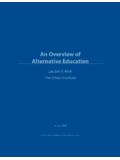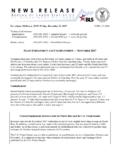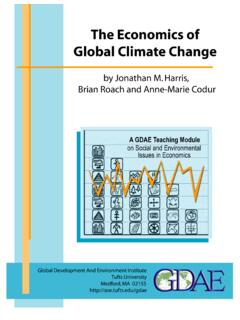Transcription of India Education Report - NCEE
1 National Center on Education and the Economy, 2005 India Education Profile Gretchen Rhines Cheney with support from Betsy Brown Ruzzi and Karthik Muralidharan National Center on Education and the Economy New Commission on the Skills of the American Workforce November 2005 National Center on Education and the Economy, 2005 2 India Education Profile India , with more than a billion residents, has the second largest Education system in the world (after China). Experts estimate that 32 percent of its current population is under the age of But counter to the image of India as a youthful engine of economic growth where many urban-based citizens work in some of the best technology-centered jobs in the world, males in India complete just years of schooling on average, females just And for the small proportion who do persist through primary and secondary schooling, the quality of instruction varies widely, depending on the region of the country and whether one is enrolled in a State-supported public school or a fee-based private school.
2 Despite the highly inefficient delivery of public services, high levels of teacher absenteeism and non-teaching activity, many Indian students remain motivated to succeed on the college entrance exams. The high level of competition for entry into the Indian Institutes of Technology, the Indian Institutes of Management and other top institutions is enough to spur millions of students to achieve at remarkably high levels, particularly in the areas of science and mathematics. The increased demand for higher Education is not currently being met: only ten percent of the age cohort is actually enrolled in higher Education . But in a country with such a large population, ten percent enrollment amounts to 9 million students, resulting in million new college graduates a year. These numbers driven by the private sector opportunities abroad, and increasingly, back in India , will continue to ensure India s prowess in delivering high-quality technical manpower.
3 Historically, Indian Education has been elitist. Traditional Hindu Education was tailored to the needs of Brahmin3 boys who were taught to read and write by a Brahmin teacher. Under British rule from the 1700s until 1947, India s Education policies reinforced the pre-existing elitist tendencies, tying entrance and advancement in government service to academic Education . Colonial rule contributed to the legacy of an Education system geared to preserving the position of the more privileged classes. Education served as a "gatekeeper," permitting an avenue of upward mobility only to those with resources. Post-primary Education has traditionally catered to the interests of the higher and upwardly mobile castes. In the nineteenth century, post-primary students were disproportionately Brahmins; their traditional concern with learning gave them an advantage under British Education policies.
4 By the early twentieth century, several other castes realized the advantages of Education as a passport to political power and managed to acquire formal learning. But even today, the vast majority of students making it through middle school to high school continue to be from high-level castes and middle- to upper class families living in urban areas. 1 The World Fact Book, CIA. 2004 estimate. 2 Public Report of Basic Education , 1999 3 Brahmin is the highest caste group in India , traditionally made up of priests, philosophers, scholars, and religious leaders. National Center on Education and the Economy, 2005 3 This historical barrier coupled with the post-independence focus of the Education system on tertiary Education more than primary Education (relative to the number of students in each category), makes it unsurprising that India has the largest number of illiterate people in the world.
5 According to the 2001 Census, more than one out of every three Indian citizens (and 42 percent of adults) is illiterate. The gap between male and female illiteracy, while still a challenge, is decreasing: 25 percent illiteracy for males and 46 percent for females. There is also a wide discrepancy in the literacy rates of different At one end, the state of Kerala has achieved 90 percent literacy, while on the other end, the state of Bihar has only 39 While the government has increased its focus on primary Education , the highly inefficient state of public service delivery in Education , with high teacher absence6 and low teaching activity even when teachers are present, is likely to keep learning levels low for the foreseeable future. India has more languages than any other country - fifteen main languages and hundreds of other languages and dialects.
6 Hindi is the national language and the primary tongue of 30 percent of the people. The other main languages are Bengali, Urdu, Punjabi, Gujarati, Tamil and Telegu. And English is ubiquitous in India , a former British colony. While not classified as one of the fifteen national languages, English is certainly important in higher Education , upward social mobility, and has played a key role in establishing India as an economic power globally. In 1997 an India Today survey suggested that about a third of the population had the ability to carry on a conversation in This was an amazing increase over the estimates of the 1980s, when only about four to five percent of the population were thought to use the language. And given the steady increase in English learning since 1997 in secondary schools and among the upwardly mobile, it is estimated that there are 350 million English-speaking Indians today.
7 This is more than the combined English-speaking populations of Britain and the India has been able to capitalize on its large numbers of well-educated people, many of whom are skilled in the English language, to become a major exporter of software services and software workers. The growth of the middle class is fueling the country s overall development. In India , there are now estimated to be some 300 million middle-income earners making $2,000-$4,000 a year in purchasing power parity (PPP) Both the number of middle earners and their income levels are likely to rise rapidly, but their incomes will continue to be substantially below averages in the US and other rich countries even by 2020. There is also sharp regional disparity in economic 4 India is made up of 29 States and 6 Union Territories.
8 5 Statistical Database for Literacy, , National Institute of Adult Education , New Delhi, 1993. Note: Kerala s 1990 Total Literacy Campaign is credited for dramatically raising literacy levels in remote, tribal areas, but some now question whether the State did truly achieve full literacy. 6 See Kremer, Muralidharan, Chaudhury, Hammer, and Rogers (2005) 7 However, the level of fluency is likely to be extremely variable, with the vast majority of people who respond to such surveys as knowing English having only extremely rudimentary comfort in the language. 8 David Crystal (honorary professor of linguistics at the University of Wales, Bangor) SubContinent Raises Its Voice. YaleGlobal Online. November 30, 2004 . 9 Basu, Indrajit. India s Growing Urge to Splurge. Asia Times Online. August 22, 2003. National Center on Education and the Economy, 2005 4 growth, with the states in the west and south growing much faster than the poorer states such as Bihar, Uttar Pradesh, and Orissa, which are likely to remain underdeveloped in the near to medium-term The pervasive low-quality Education available to the masses has led the government -- in its five year plans which outline the country s development strategy -- to move funding away from the higher Education system overall (although not to the detriment of the crown jewels of the system: the Indian Institutes of Technology and the Indian Institutes of Management) toward basic primary and middle stage Education in an effort to boost the abysmally low literacy rates.
9 Primary and Middle Education The Indian Constitution made a commitment to make primary and middle grade Education (for students ages 6-14) free and universal by 1960, with the two national policy statements on Education in 1968 and 1986 (and revised in 1992) placing much emphasis on this goal. But India s inability to allocate resources effectively and efficiently has made that goal unattainable even 45 years later. There has, however, been a considerable increase in the spread of educational institutions since India gained its independence in 1947. For instance, during the period 1950-51 and 2001-2002, the number of primary schools grew three-fold, while the number of middle (upper primary) schools increased 16 times. Today India has more than six hundred thousand11 primary schools serving 115 million students (the average teacher to student ratio is 1:43) and more than two million upper primary schools serving 45 million students (the average teacher to student ratio is 1:38).
10 Another recent trend is the growth of private schools that receive no government aid and rely on student The Indian school system follows the British structure. Primary school consists of grades 1-5 (ages 6-11) and middle school consists of grades 6-8 (ages 11-14). Both are compulsory. However, researchers estimate that an average of 70 percent of children between the ages of 6 and 14 actually attend Emphasis on reform has been on compulsory school attendance, rather than on any measure of expected learning. Quality of state-run schools ranges from top-notch to abysmal. Private schools are, on the whole, better but many of them charge high fees making them accessible only to the middle and higher class families and admissions can be highly competitive. A recent phenomenon has been the proliferation of low-cost 10 Report of the National Intelligence Council's 2020 Project.

















